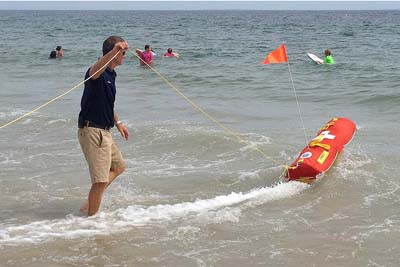
Misquamicut, R.I., Fire Chief Louis Misto, left, holds a line attached to the EMILY remote-control lifesaving device.
WESTERLY, R.I. (AP) � Think of a lifeguard and you might conjure up images of sunburned teenagers working a summer job. A new and relatively inexpensive lifesaving device could change that.
Meet EMILY, a remote-controlled lifeguard. It looks like a buoy, but it's a small watercraft fitted with a flotation device. It can go up to 22 mph and can get to people more quickly, and in some cases more safely, than any human.
It's being used by a handful of communities. Last month, it was used in its first rescue.
"In the day and age of shrinking budgets and the availability of personnel, this is just another thing we can use," said Joshua Williams, chief of the Depoe Bay Fire District in Oregon, which performed the rescue with it July 15. "It's proven itself by saving a father and a son. It's really all the proof that we need."
EMILY stands for Emergency Integrated Lifesaving Lanyard. It's a little over 4 feet long, weighs 25 pounds and costs about $10,000. It's made by Hydronalix, a Green Valley, Ariz., company established in 2009.
If a swimmer is struggling, a lifeguard or anyone else can put battery-powered EMILY in the water and, with a remote control, send it through even rough waves to help. Some locations attach an emergency radio so they can instruct panicked swimmers on what to do.
EMILY can't bring swimmers back to shore, but it can keep them safe until rescuers get there, or be attached to a rope so rescuers can pull EMILY and anyone holding on back in.
In Los Angeles County, the lifeguards made famous by the TV series "Baywatch" use EMILY to shoo people away from rip currents, said Rori Marston of Hydronalix.
EMILY doesn't replace a lifeguard. Someone must be on shore to operate EMILY, and lifeguards have skills EMILY can't replicate. EMILY also can't be used if a swimmer is unconscious.
Louis Misto, chief of the Misquamicut Fire District in Westerly, said he was skeptical but soon changed his tune.
"When you're talking about getting right into the surf line, where most of these drownings or rescues take place, EMILY is going to be one of the most useful tools," he said.
Westerly bought two EMILYs this summer after Barbara Stillman, who runs a beach resort, proposed the idea. Over the years, she has jumped in to help distressed swimmers when lifeguards are off duty.
"They're so panicked that they push you down," she said.
She has been trained on how to use EMILY for the next time that happens.
"I could run over there and grab EMILY and put a rope on her, throw her in the water, and bring her in myself," Stillman said.
Depoe Bay has no lifeguards and a small volunteer fire department to cover about 16 miles of rocky coastline. The water is cold, the currents are strong and not every firefighter knows how to perform water rescues, Williams said.
In the July rescue, when firefighters arrived, the father was exhausted, having already saved one son from a rip current. He was swimming toward another son, the mother frantic on the beach, Assistant Chief Hank Walling said. In the past, they would have had to call in a Coast Guard helicopter or find a firefighter certified to swim.
Instead, they sent EMILY.
News of the rescue was validation for communities using it.
"It's an awesome tool," Stillman said. "I know all it's going to take is one life. Then, to me, it's worth all its value."
BY MICHELLE R. SMITH / Source: Associated Press
| ![]()




